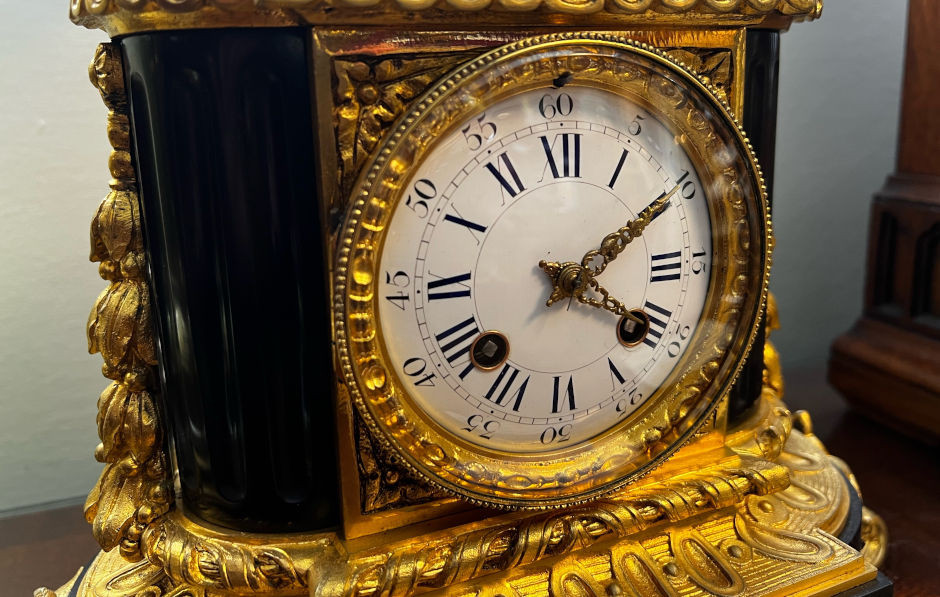
Our latest expert guide looks at that most enduring type of clock, the antique mantel clock.
Of all the types of antique clocks available to collectors, the antique mantel clock remains the most popular, perhaps for its ability to work equally well in both period and contemporary settings. Intended to sit on a shelf or the mantel above a fireplace, these charming clocks are usually small enough to be carried by hand and hence lack the carry handles of their predecessor, the chamber clock. Here, we tell you what to look for before making a purchase.
How do I identify an antique mantel clock?
Dating back over 250 years, the mantel clock can be found in a variety of styles but, in general, the following are characteristics that will help to identify an antique mantel clock.
The mantel clock mechanism
While the first clocks to be powered by mains electricity date back to the 1840s, the majority of antique clocks will feature a wind-up mechanism, and NEVER a battery. They will need to be wound up weekly or fortnightly, with those needing attention once a week being referred to as 8-day clocks. The face of the clock will feature keyholes – one for clocks that tell the time only and two for those that chime on the hour and half hour.
The mantel clock design
Of the hundreds of styles to be found, there are some classic designs to watch out for:
Bracket – named after the wall mounted clock that hung from brackets which came before them, bracket mantel clocks feature a handle at the top. This gave the clock portability from room to room at a time when many households could afford only one clock.
Steeple – these date back to 1845 America and were designed in the Gothic style, with a triangular, peaked top flanked by columns. Variations include the beehive steeple and the double steeple.
Tambour – the most popular design for the 20th century British mantel clock, this classic style has a round case encompassing a round dial, with an upright drum which curves out as it tapers to an extended base.
Materials used for antique mantel clocks
Antique mantel clocks were most commonly manufactured from stone (onyx, marble), wood, metal (brass was often used in early French examples) and porcelain (usually highly decorative with painted designs). However, some were made from precious metals (gold and silver) and these clocks are today very rare and therefore also highly valuable.
How do you know if an antique clock is valuable?
Evaluating an antique mantel clock accurately takes years of experience but, as with any antique item, collectors should look for age, condition, and rarity along with other factors such as materials and maker.
Condition – antique mantel clocks are categorised as being in mint, excellent or good condition. A mint condition example will have no damage, or signs of repair, and will be complete, with no missing parts. A clock in excellent condition may have superficial flaws and, where it has been damaged, it will have been repaired by experts. A clock in good condition will show signs of ageing and wear, in the form of discolouration, visible signs of repair, chips or cracks to the casing and cracks on the face.
Maker – the maker of any clock impacts significantly on its value. Look for a signature or even a label, usually on the base of the clock. Notable makers include Baetens of London, Le Roy & fils of Paris and Jean-Baptiste Delettrez, as well as more widely known names such as Mappin and Webb.
Rarity – this does not always correspond to the number of items available although usually, if something is considered rare, it is understood there were very few made originally. This is not always the case though, and an item can be considered rare if there are plenty of examples but owners do not wish to sell.
Age – as a general rule of thumb, the older the clock, the higher its value, although the other factors mentioned here do need to be taken into account; an 19th century mantel clock for example from a little known maker that is in good condition may not be as valuable as an early 20th century piece from a reputable maker in excellent condition.
Antique mantel clocks for sale
Wherever possible, always buy from reputable dealers and antiques experts like the dealers at Hemswell Antique Centres. In this way, you can have the confidence that the antique mantel clocks for sale are authentic. Our mantel clocks are included amongst a wide variety of different types of antique clocks for sale online with many more available to view in person at the centres.